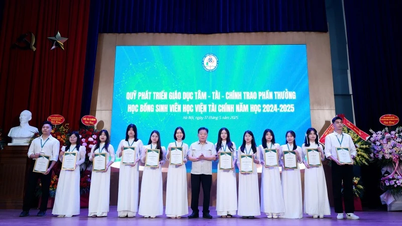From the history of Vietnamese Jazz
In the preface to the book, Dr. Stan BH Tan-TangBau writes: “ If I may be so bold as to say, Quyen Van Minh’s life story actually says a lot about how jazz began in Vietnam. By comparison, there is no individual in other countries in Asia or Eastern Europe to whom we can credit the entire development of jazz to become a truly mainstream music in their countries.
 |
In the case of Socialist Vietnam, Minh's efforts to open up the dynamics, from performing jazz in public to teaching jazz, both formal and informal, all contributed to the efforts to shape an original Vietnamese voice to perform with the diverse sound textures of world jazz, and most importantly, to create a public space for jazz musicians and Vietnamese people to listen to jazz.
His efforts gave credence to the efforts of the national conservatory, now known as the Vietnam National Academy of Music, to eventually make jazz a subject leading to an intermediate certificate, and then a bachelor’s degree in professional music education. It is appropriate to begin the story of jazz in Socialist Vietnam with the story of the Ming Dynasty.”
Jazz - a musical genre originating from the African community in the United States in the late 19th - early 20th century, has spread throughout the world and is present in every national musical culture. Jazz music is full of artistry, full of characteristics and makes listeners who like it like a lover of it.
In Vietnam, jazz also has many of its own stories and "introductory" knowledge to explore , such as who are the Vietnamese jazz players in Vietnam? Where and how did they learn to play jazz? Did they really "play jazz"? Was jazz ever banned?...
 |
To the aspiration of an artist
These questions will be answered in “Playing Jazz in Vietnam: Quyen Van Minh and Hanoi Jazz” - a book that recounts the journey of jazz's birth in Vietnam, focusing on the story of artist Quyen Van Minh - who devoted his life to developing jazz in his homeland, to vividly recount how jazz is heard, learned and performed here.
He is affectionately called: "The Godfather of Vietnamese Jazz", because without his love, passion and journey to bring Jazz to the public, surely today, Vietnam's musical life would lack an important part, Jazz music.
Dr Stan BH Tan-Tangbau studies cultural narratives and socio-political change in Vietnam and mountainous regions across Southeast Asia. His work has appeared in journals such as Jazz Perspectives, Collaborative Anthropologies, Journal of Narrative Politics and Journal of Vietnam Studies. He has taught at Ritsumeikan University in Kyoto and the National University of Singapore.
Stan BH Tan-TangBau is not only a dedicated scientist but also has a love for jazz music and a special affection for the pioneer of jazz in Vietnam: Quyen Van Minh. Dr. Stan met Quyen Van Minh during a performance in Singapore, convinced by his music, Dr. Stan went to Vietnam, to Binh Minh Jazz, which was then in Luong Van Can, to meet and talk with Quyen Van Minh.
The book is a collection of conversations from 2009 and from 2012 to 2016. During the process of making this project, artist Quyen Van Minh transferred to Stan all the articles and magazines, old documents and any memorabilia he still kept from the years of his musical life.
And the book was born, it not only encapsulates the life of an artist, but in it, we also see the social context, the hardships of the times that artists, if not in love, not passionate, will not overcome to be able to play music. I was impressed by the cultured and visionary way of looking and thinking of the mother, to whom artist Quyen Van Minh said, he was grateful for the rest of his life.
“When my mother put the clarinet in my hands, she said: “I just want you to play well. Even if you only earn one dong from playing the clarinet, it is still worth more to me than a billion dong from someone else”. And it was also my mother who took off the ring on her finger and gave it to her son when Quyen Van Minh needed money to buy a saxophone for his first solo performance. From her teachings and encouragement, artist Quyen Van Minh dared to pursue his musical dream.
 |
Each story in the book reflects the intersection of personal life experiences and the musical atmosphere created in the socio-political context of Vietnam at different periods. Therefore, in addition to the musical aspect, the book is also considered a valuable source of reference material on anthropology and sociology.
The book reads like a chronological list of scores. Score 1 begins with a declaration that jazz is an official part of the mainstream Vietnamese soundscape.
Track 2 introduces the reader to the central pillar of jazz in Hanoi, Minh's Jazz Club. Track 3 provides the historical context in which Quyen Van Minh was born and raised, namely the Vietnamese Revolution and the Second Indochina War. Track 4 provides a broader context of jazz in Eastern Europe to help provide a more nuanced appreciation of the intersection of art and culture and politics in socialist regimes throughout the Cold War.
Track 5 tells the story of Quyen Van Minh’s second and third encounters with jazz in the 1970s. Track 6 tells the story of Quyen Van Minh’s return to professional music in the late 1970s, which led to a fateful trip to East Berlin that cemented his determination to play jazz in Vietnam. Track 7 tells the behind-the-scenes story of how Quyen Van Minh’s first public performances introduced the sound of jazz to Vietnam in 1988 and 1989.
Track 8 is a detailed account of Quyen Van Minh's concert at the Hanoi Opera House on April 12, 1994, which premiered three of Quyen Van Minh's original jazz compositions, marking the birth of Vietnamese jazz. Track 9 tells the story of Quyen Van Minh as a saxophone and jazz teacher. Track 10 presents some familiar motifs that can be identified in the development of jazz in Asia, and is relevant to an appreciation of jazz in Vietnam.
Track 11 looks at Quyen Van Minh’s jazz compositions and the albums he recorded as a jazz musician and saxophonist. Track 12 is essentially a monologue from Minh about how he sees his jazz club as a place where musicians can learn to play jazz, gain the confidence to develop their own voices, and indulge in their passion for jazz. Track 13 briefly summarizes the state of jazz in Vietnam in parallel with Quyen Van Minh’s life.
I have a dream, a dream of playing jazz in Vietnam. Because of jazz, I have encountered many hardships. Because of jazz, I have received much happiness and joy. Now I have retired from the conservatory. That is my work for the country. But my work with the saxophone never stops.
Artist Quyen Van Minh shared in the book: “My name is Van Minh, in “civilization”, and my last name is Quyen, in “rights”. So I think that I “have the right to live a civilized life”. I have the right to live a life of dignity and civilization despite the hardships and challenges in my jazz journey…
"I have a dream, a dream of playing jazz in Vietnam. Because of jazz, I have encountered many hardships. Because of jazz, I have received much happiness and joy. Now I have retired from the conservatory. That is my work for the country. But my work with the saxophone never stops."
Playing Jazz in Vietnam: Quyen Van Minh and Hanoi Jazz seeks to fulfill this role by placing the personal story of a musician at the center to vividly tell the story of jazz. His efforts gave credence to the efforts of the national conservatory, now known as the Vietnam National Academy of Music, to eventually make jazz a subject leading to an intermediate certificate, then a bachelor’s degree in professional music education.
 |
The work is a stepping stone for further research and understanding of jazz in Vietnam, included in the Omega Plus Music Library. The book summarizes the life of an artist who has been attached to Jazz, considering Jazz as his life, but for artist Quyen Van Minh, it opens a new path, nurturing the young generation to bring Vietnamese Jazz beyond the borders.
Source: https://nhandan.vn/doc-sach-cuoc-tro-chuyen-thu-vi-voi-jazz-post730699.html


![[Photo] More than 17,000 candidates participate in the 2025 SPT Competency Assessment Test of Hanoi National University of Education](https://vphoto.vietnam.vn/thumb/1200x675/vietnam/resource/IMAGE/2025/5/17/e538d9a1636c407cbb211b314e6303fd)



![[Photo] Readers line up to visit the photo exhibition and receive a special publication commemorating the 135th birthday of President Ho Chi Minh at Nhan Dan Newspaper](https://vphoto.vietnam.vn/thumb/1200x675/vietnam/resource/IMAGE/2025/5/17/85b3197fc6bd43e6a9ee4db15101005b)
![[Photo] Prime Minister Pham Minh Chinh chairs meeting on science and technology development](https://vphoto.vietnam.vn/thumb/1200x675/vietnam/resource/IMAGE/2025/5/17/ae80dd74c384439789b12013c738a045)



















![[Photo] Nearly 3,000 students moved by stories about soldiers](https://vphoto.vietnam.vn/thumb/1200x675/vietnam/resource/IMAGE/2025/5/17/21da57c8241e42438b423eaa37215e0e)






































































Comment (0)